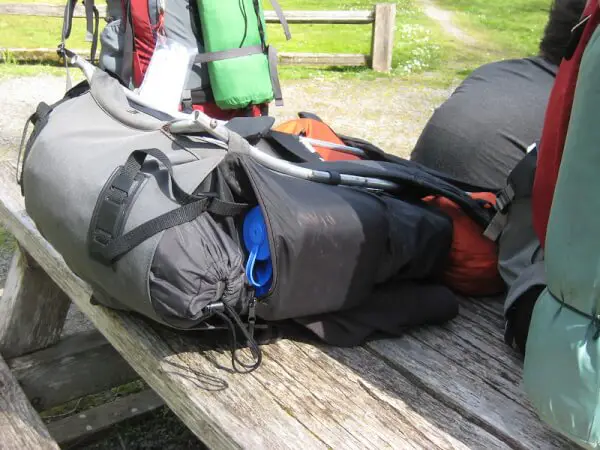When you are preparing for outdoor adventures and choosing the appropriate equipment for for tackling the wilderness, the most important gear which deserves your attention is definitely a backpack. Buying a backpack is probably the most critical purchase that you can make, since the quality of your outdoor trip can depend on the backpack you carry.
Therefore, it is not only important to take the time to choose the most appropriate, convenient and practical pack, but also not to be mistaken in deciding what type of a backpack is better. All backpacks that are available on the market today can be divided into two types: internal frame and external frame backpacks.
Therefore, if you want to buy a pack for your outdoor trips, you have a tough choice to make: internal vs external frame backpack – which one will be better, and what are the differences between them?
The aim of this article is to answer these questions and help facilitate your choice. In addition, we will also provide you with useful information on what should you consider when choosing a backpack and how to pack it depending on the type of the frame.
External frame backpacks
External frame backpacks are characterized by highly rigid aluminum tube frame. They are classic and historic packs that were earlier used by soldiers during the U.S. Civil War. These backpacks are made specifically for carrying very heavy loads over long distances, therefore they are considered to be quite tough and durable. For a review of the top external frame backpacks, check out our article on this topic.
Usually this type of backpack is preferred by backpackers on long hikes, hunters or experienced travelers. External frame backpacks have both their own pros and cons that are going to be discussed below.
Advantages
Ability to carry more weight
As mentioned above, backpacks of this type are perfect for long trips and hikes, during which you have to carry more equipment. Most external frame packs have the ability to carry up to 100 pounds.
More room between a backpack and the body
Due to a specific design of an external frame backpack, there is enough space between the pack and the torso, which means that the air circulates more easily. It is especially important and beneficial during hikes in summer time, when you sweat a lot.
Constant circulation of the air creates much more comfortable and pleasant hiking conditions, even if you carry a very heavy backpack.
Price
Many people choose an external frame backpack because they much cheaper and affordable. Therefore, usually such backpacks are chosen by less experienced outdoor lovers and by those, who are buying their first backpack.
Thus, external frame backpacks of smaller sizes and made of less durable materials will cost approximately $35 USD. The prices of the most expensive range from $150 to $250 USD. The best option is a backpack, the price of which is between $99 and $130 USD.
Disadvantages
Despite meaningful advantages of external frame backpacks discussed and described above, there is also a number of disadvantages that need to be taken into consideration before purchasing.
Can be heavy
External frame backpacks cannot be considered lightweight – even when they are completely empty, they still weigh a lot. Therefore, you should make sure that you have the body frame to carry a heavy external frame pack. Check out our top ultralight backpacks to help you with excellent choices.
Bad stability
Even though such backpacks are strong and are able to carry a lot, they are not know for good stability: when such packs are full, they are more likely to shift from side to side. As a result, this negatively influences the balance and makes hiking much more challenging and difficult.
Big and inconvenient frame
The frame of external frame backpacks is quite big and awkward, therefore it might be problematic to store a backpack inside a tent. Thus, during a rainy weather and you do not want your stuff to get wet, you will need an additional cover for your backpack.
Internal frame backpacks
An internal frame backpack features a frame that is not immediately visible. This type of backpacks is considered to be quite innovative because it was introduced only in 1967 by Greg Lowe, the founder of a famous company Lowepro. The frame is usually made either of plastic or metal and integrated into the material. Check out our top list of the best internal frame backpacks to help you with more options.
Nowadays, internal frame packs are chosen by most hikers due to their modern and attractive design. Today, most of manufacturers produce this type of backpacks. As with external frame packs, internal ones have their own advantages and disadvantages.
Advantages
Good position
Due to a flush position of the pack against the back, the overall center of gravity is kept as close as possible to a natural position.
Large containment
These backpacks have quite spacious internal capacity, so you will have enough space for keeping most of your equipment safe and protected.
Adjustable shoulder straps
Most modern internal frame packs have such shoulder straps that are very convenient and easily adjustable. Thus, this makes the backpack a suitable choice for people with varying heights.
Compact size
These backpacks are not very large, so when they are empty, it is quite easy to transport them and even check them in as a piece of luggage for a flight.
Great mobility
Most modern backpacks are respected and appreciated by their mobility, due to which a backpack forms to the body. Thanks to this natural position, you have a feeling that the backpack is becoming a part of you.
As a result, you have better control and balance while hiking event in the tightest and the most difficult terrains and trails.
Disadvantages
Not all types of packs are perfect, and this one is no exception. Even though internal frame backpacks are extremely popular nowadays and are chosen by most outdoor lovers, there is some noteworthy disadvantages.
Close position to the body
Since these backpacks have an anatomic design, they are worn too close to the body, which might become a significant disadvantage if you carry it in warm conditions. The closer pack to the body is, the worst the ventilation can get. As a result, you will sweat more and feel less comfortable while hiking.
Higher price
In contrast to external frame backpacks, these packs are much more expensive, and their average price on the market is between $200 and $300.
A limited amount of external pockets
Since usually most models of internal frame backpacks have a very limited amount of external pockets, most of the stuff has to be kept inside the internal containment, which might be a problematic if you have a lot of equipment.
How to choose a backpack
Regardless the type of a backpack that you decided to purchase it is important to know how to choose a pack and what features are the most important
Waterproof qualities
If you are going to use your backpack in outdoor conditions quite often, it is worth choosing a backpack that is made of a waterproof material. It does not mean that your backpack should be 100% waterproof – semi-waterproof fabric can be also enough, as long as it prevents your belongings from getting wet in a drizzle. See our article on how to choose the best waterproof hiking backpacks to help you with choices.
It is also important to make sure that the material of the pack does not stay wet very long and does not get musty. The best solution would be in this case to choose thick but lightweight material at the same time.
Multiple compartments and side pockets
The more compartments and pockets you have, the easier it is for you to organize your stuff in the backpack. Moreover, if you have enough side pockets, you can always put in them small things by leaving a large inside compartment for bigger and more necessary stuff, including clothing and a sleeping bag.
Padded hip belt and shoulder straps
Since most of the weight you carry in your backpack should be pushed down on your hips, it is necessary to have a pack equipped with a padded and strong hip belt. This is to provide necessary support and distribute the weight more evenly on the back.
It is also important to note that the hip belt should be adjustable, so you can always tighten it more in order to get more support. With regards to shoulder straps, their role is also very important because they increase the level of comfort when you are carrying a heavy load. The shoulder straps do not only reduce the pressure on your shoulders, but also on your lower back. As a result, at the end of a long hiking day you will not feel as exhausted.
Size of the backpack
There often exists a misunderstanding that a perfect backpack should be of a certain size and dimensions. However in reality, the size of the backpack fully depends on your personal needs, preferences and conditions in which you are going to use the pack.
The only thing regarding size that is really important is that a backpack should be proportional to your body. If it is too big, its weight will not be balanced properly, which will lead to pain in the shoulders and the back. Instead of the size of a backpack, it is more recommended to think about its volume.
Usually, the smallest packs have the volume of 15 liters, while the most spacious modelshave more than 55 liters. If you want to buy a backpack for short day hikes, then it is recommended to purchase a pack with the volume of 30 liters maximum.
For short hikes and journeys that last up two days, the best choice will be a backpack of 30-50 liters. The volume of 45-55 liters is preferred by customers who tend to spend the whole weekend outdoors and therefore need stuff for at least several nights. In case if you plan an extended trip that lasts more than 3 days, then definitely choose a backpack that has a volume of at least 55 liters.
The price
As it has been described above, the price of a backpack depends on its type: internal frame packs are more expensive than external frame ones. In average, the price of a backpack is between $99 and $300 USD. It is definitely not worth spending several hundred dollars on a backpack, so the optimal price will be around $150 USD. However, it all depends on what your budget will allow you.
How to pack a backpack
To choose and buy a proper backpack is not enough – it is also important to know how to pack in a way that it does not become an excessive burden during your trip. The purpose of proper packing is not just to accommodate all the necessary things that are needed for the trip, but also distribute weight in a proper way, so you will achieve the highest level of comfort, stability and convenience.
It is also important to know and into consideration that there are differences in the system of packing internal and external frame backpacks. See our most useful tips on how to pack a backpack for reference.
With packing an internal frame pack, you should know that it is necessary to center items with the most weight high between shoulder blades and as close as possible to your back. This will allow to place the weight on the hips, the task of which to keep and carry most of the weight of the backpack.
However, if you are off the trail, then it is better to remove heavy items lower on the back, which will lower the center of gravity and provides you with better stabilization and balance on rough terrains.
If you an owner of an external frame backpack, then it is advised to place the heaviest equipment on the top of the pack and close enough to the back. By doing this, you center the backpack’s weight over your hips and help yourself to remain in a more upright position.
Regardless the type of a backpack that you have, there are also some other general things that should be remembered.
First of all, it is important to know that medium sized things including first-aid kit, pillow, water filter and stove, should be better placed in the middle and far enough from the back. Lightweight items such as clothing or sleeping bag are preferably placed in the lowest part of the pack.
You should also be careful with the total weight of the backpack: regardless the type of frame in it, it is better not to overload it. An ideal weight of a stuffed backpack is not more than 30% of the body weight. Of course, if you are an experienced backpacker and hiker, you might be able to carry much more. However, if you have never carried a heavy backpack before, then it is even better to start with a lower weight.
Final words
So there you go, the two main types of backpacks that you can buy in the market. Though at first sight they seem to be absolutely similar, there are many distinct differences between them. We hope that this article has helped you understand these differences and decide, what type of a backpack is more preferable and appropriate for your outdoor trips.
Featured Image Source: https://www.flickr.com/photos/74616830@N00/3487149838








